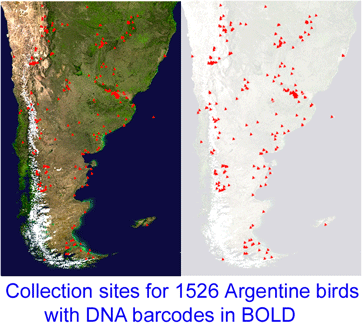The Neotropics, comprising southern Mexico, Central America, Caribbean, and South America, is home to over 4,000 bird species, representing over 40% of world birds. In this post, Pablo Tubaro, Museo Argentino de Ciencias Naturales (MACN), Buenos Aires, Argentina, sends this update on DNA barcoding birds of Argentina:
 “This project, which started in December 2005, is a collaboration between MACN and the Biodiversity Insitute of Ontario/Canadian Center for DNA Barcoding (BIO/CCDB). In November 2006 the project was boosted by a grant from the Richard Lounsbery Foundation that supports expanded collecting efforts in Argentina, training of Argentine students at CCDB (2 trained so far), and establishment of a DNA laboratory at MACN.
“This project, which started in December 2005, is a collaboration between MACN and the Biodiversity Insitute of Ontario/Canadian Center for DNA Barcoding (BIO/CCDB). In November 2006 the project was boosted by a grant from the Richard Lounsbery Foundation that supports expanded collecting efforts in Argentina, training of Argentine students at CCDB (2 trained so far), and establishment of a DNA laboratory at MACN.
A special feature of this project is that it started literally from scratch. As there were no significant collections of frozen bird tissues with associated vouchers in Argentina, we started by resampling the country from north to south, conducting joint campaigns in collaboration with researchers from several North American institutions including American Museum of Natural History, Cornell University, Louisiana State University, Queen’s University, University of Alaska, and University of Kansas. At present our frozen tissue collection with associated vouchers includes more than 3100 samples and is growing rapidly. We will be doing field work at Iguazu National Park in November and December and aim to have collected 70% of Argentine birds by the year’s end.
Results so far show interspecific and intraspecific levels of divergence in COI squence are similar to published results with North American birds. In more than 98% of cases, the COI sequences belonging to different species do not overlap. In addition, in 3% of cases Argentine birds show distinct COI sequence clusters, suggesting the possible existence of cryptic species or geographical races that deserve species status. At this moment, four doctoral and post-doctoral fellowships have been requested or are already awarded by the National Research Council of Argentina (CONICET) and the National Science Foundation of Argentina (ANPCyT) to study in depth the phylogeographic structure of some of the interesting cases revealed by our DNA barcode survey.”
Congratulations to Pablo Tubaro and his team on their rapid progress in DNA barcoding Argentine birds, creation of a significant avian tissue and skin collection at MACN, and on recognition of the value of this work by science institutions in Argentina!
Barcoding the DNA of birds and other species looks like it is really moving along. There is a really cool tool that can incorporate the barcode of the species with the image and place them on product that you can use. Check out this barcode label maker and just email the image of the species to have the product made with the barcode and the image. It could be a great way to get the word out on a new bird and the DNA barcoding project.
This is pretty amazing how barcodes can be used.
Barcode is currently the most popular technology used in identification industry. I’m not amzing when see it used in DNA bird identification. However, I thought that this technology will be replaced by RFID in identification technology
Like the expression “DNA fingerprinting”, “DNA barcoding” is a metaphor, which in this case refers to using a short DNA sequence as an identifier for organisms. In contrast, identification methods for commercial products, include optical barcodes and RFID (radio frequency identification), involve applying physical tags to items.